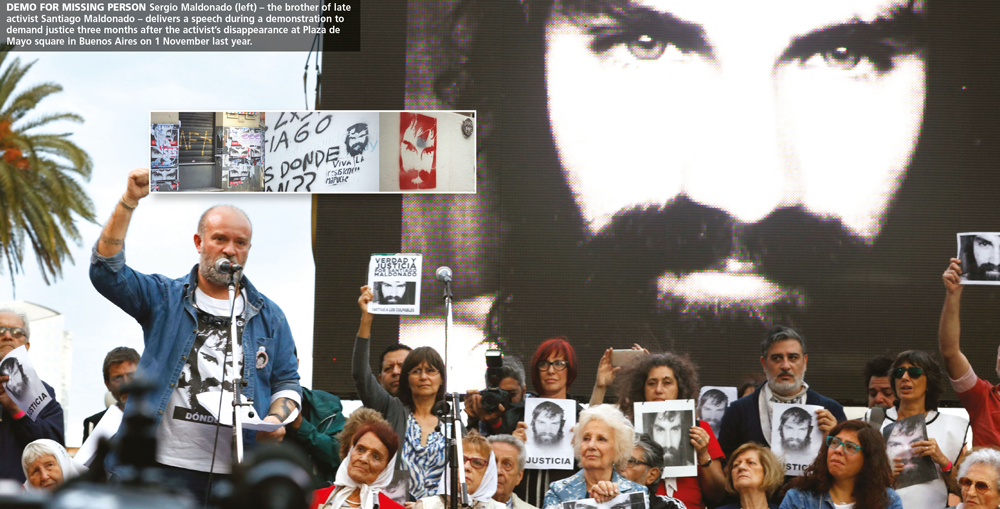A CRY FROM ARGENTINA
THE MAPUCHE: A MARGINALISED PEOPLE
Yasmin Helal reports from Argentina on the struggle by the Mapuche for freedom and justice – and the right to reclaim their land
Located on the southernmost tip of Latin America, Argentina prides itself on being the ‘whitest’ country in the region with about 97 percent of its population being of European origin. Its capital Buenos Aires promotes itself as the ‘Paris of South America.’
This ‘whiteness’ makes the country stand out in the region especially since the majority of its population comprises mostly those of mestizo ethnicity, which is a mix of European and indigenous people. Argentina’s purely indigenous people amount to only three percent of the populace and they have seen very little justice over the years.
A centuries long struggle of the Mapuche (‘people from the land’) attempted to defend their territory and dignity. They’re the original inhabitants of a vast swathe of land that’s now Chile and Argentina.
The Spanish had signed the Treaty of Quillin, which defined the traditional land of the Mapuche. But following the defeat of the Spanish in 1810, Chile and Argentina abrogated this treaty and established their own pact, which resulted in the gradual land grab of Mapuche territory.
In ancient times, the Mapuche fought against the powerful Inca Empire to retain their vast territories that stretched on both sides of the Andes Mountain range. Today, they live in much smaller territories in Argentina scattered around the provinces of Chubut, Neuquén, Santa Cruz and Rio Negro in Patagonia, as well as La Pampa and Buenos Aires.
And in Chile, they live in the urban areas of Santiago, Concepción, Valparaiso, Temuco and Valdivia.
The size of today’s Mapuche population in Argentina is the subject of controversy with the government claiming it to be 100,000 while the Mapuche’s figure is five times higher. The majority of the Mapuche don’t own land and those who do are usually given less fertile land on the outskirts of cities, which leaves them in poverty and isolation.
Recently, their struggle became a hot topic with the death of Santiago Maldonado, a 28-year-old activist. He disappeared in August last year following a violent raid, which was carried out by the Argentine National Gendarmerie on the Mapuche community Pu Lof in the province of Chubut.
The attack was initially aimed at displacing activists like Santiago who had gathered in the area to protest against the arrest of Mapuche leader Jones Huala. This piece of land is the subject of a longstanding dispute between the Mapuche (who claim a small part of the territory as their ancestral land) and the Benetton Group, which is the legal landowner.
“All human rights are being violated here, which forces us to harden our forms of resistance. We use whatever we have at hand. We use stones and sticks as self-defence against the paramilitary and para-police groups,” Huala told the local press in a telephone interview from his jail cell.
Santiago’s body was recovered later in October on the banks of a frozen river in Patagonia. He had last been seen only 100 metres away, surrendering to members of the Gendarmerie. During the period between his disappearance and discovery of his body, Santiago’s name dominated local news headlines from television to the front pages of the press. It prompted angry protests around the country and attracted international attention.
Director for the Americas at Amnesty International Erika Guevara Rosas stated: “The judicial authorities must make progress in an impartial, independent and comprehensive investigation to determine the cause of death of Santiago Maldonado – and should any state agents be found responsible for this death, they must be brought to justice without delay or interference of any sort.”
Santiago’s murder brought the Mapuche cause (which had been ignored for years) to the forefront of the current political discourse in Argentina. It is also a stark reminder of Argentina’s dark legacy of military dictatorships that resulted in the disappearance of about 30,000 people in the 1970s and early ’80s.
It was perhaps this international attention that pressured the government into taking the matter seriously.
Previously, local politicians and especially the Minister for Security Patricia Bullrich seemed apathetic about the case – she even attempted to cast suspicions on the protesters, suggesting that Santiago might have been stabbed by the Mapuche themselves.
However, according to the official autopsy report, the cause of death was hypothermia and drowning. But even this has been countered by unofficial autopsy studies and reports that mooted the theory that Santiago’s body might have been planted in the river days before it was discovered.
Photos of Santiago’s face can be seen on street walls in Buenos Aires. Whether or not this condemnation of murder is due to the fact that Santiago is considered a white Argentinean is up for debate.
His death is not the only casualty resulting from the Mapuche struggle in Argentina but so far, it’s the only one that has received this sort of coverage. In fact, violence directed at activists from indigenous backgrounds is hardly ever mentioned in the news.
Students in Buenos Aires believe that several factors played out in favour of Santiago’s case including the colour of his skin, the social status of his family and his left-wing ideology.
Apparently, Argentinian justice isn’t colour-blind.





